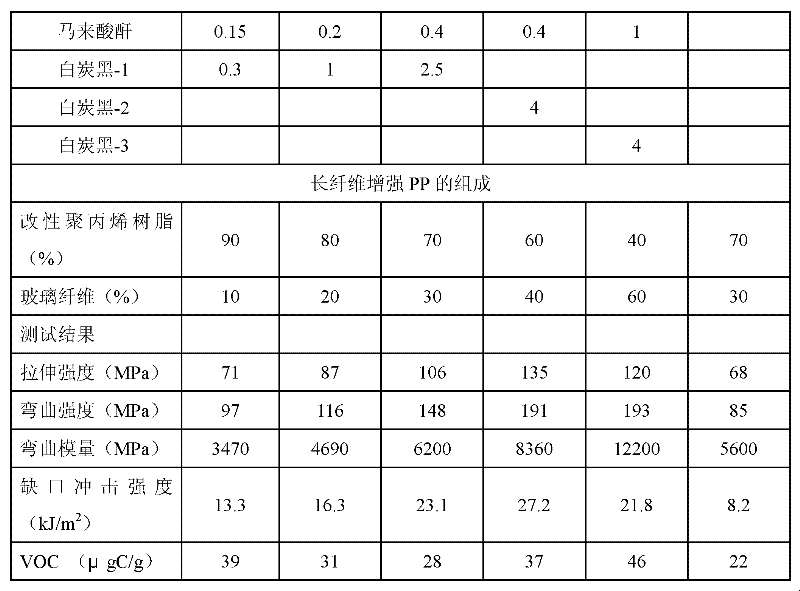Low-VOC (volatile organic compound) long glass fiber reinforced polypropylene composite material and preparation method thereof
A technology of long glass fiber and polypropylene materials, which is applied in the field of low VOC, long glass fiber reinforced polypropylene composite materials and its manufacturing, and can solve the problems of reducing the fluidity of crystalline polymer substrates, performance degradation of reinforced composite materials, and insufficient fiber Impregnation and other issues, to achieve good low VOC emission performance, good tensile, excellent heat resistance
- Summary
- Abstract
- Description
- Claims
- Application Information
AI Technical Summary
Problems solved by technology
Method used
Image
Examples
Embodiment 1
[0039] Use the TE-35 (length-to-diameter ratio L / D=48) twin-screw extruder that has side feeding port, add 900 grams of polypropylene resin PP-1, 0.5 gram 1,4-( Two tert-butyl peroxy) dicumyl and 1.5 grams of maleic anhydride, add 3 grams of white carbon black-1 and 95 grams of polypropylene PP-1 of the remaining part at the side feed port. The processing temperature (from the feed port to the die head) is: 140°C, 180°C, 200°C, 220°C, 240°C, 240°C, 260°C, 260°C, and the speed of the main machine is 300rpm.
[0040] The compound and the continuous glass fiber melted and reacted by the extruder adopt the pultrusion process, the impregnating temperature is 240°C, and the impregnated head is cooled and cut into pellets, and the fiber weight percentage is 10% and its length is the same as that of the resin pellets. The long glass fiber reinforced PP pellets with the same material length were used to prepare standard mechanical test samples by injection molding machine. The test res...
Embodiment 2
[0042] Use the TE-35 (length-to-diameter ratio L / D=48) twin-screw extruder that has side feeding port, add 900 grams of polypropylene resin PP-1, 1 gram of 1,4-( Two tert-butyl peroxy) dicumyl and 2 grams of maleic anhydride, add 10 grams of white carbon black-1 and 87 grams of polypropylene PP-1 of the remaining part at the side feed port. The processing temperature (from the feed port to the die head) is: 140°C, 180°C, 200°C, 220°C, 240°C, 240°C, 260°C, 260°C, and the speed of the main machine is 300rpm.
[0043] The compound and the continuous glass fiber melted and reacted by the extruder adopt the pultrusion process, the impregnation temperature is 260°C, and the fiber weight percentage is 20% and the length is the same as the resin pellet. The long glass fiber reinforced PP pellets with the same material length were used to prepare standard mechanical test samples by injection molding machine. The test results are shown in Table 1.
Embodiment 3
[0045]Use the TE-35 (length-to-diameter ratio L / D=48) twin-screw extruder that has side feeding port, add 900 grams of polypropylene resin PP-1, 1 gram of 1,4-( Two tert-butyl peroxy) dicumyl and 4 grams of maleic anhydride, add 25 grams of white carbon black-1 and 70 grams of polypropylene PP-1 of the remaining part at the side feed port. The processing temperature (from the feed port to the die head) is: 140°C, 180°C, 200°C, 220°C, 240°C, 240°C, 260°C, 260°C, and the speed of the main machine is 300rpm.
[0046] The compound and continuous glass fiber melted and reacted by the extruder adopt the pultrusion process, and the impregnation temperature is 260°C. After passing through the impregnation head, it is cooled and cut into pellets, and the fiber weight percentage is 30% and its length is the same as that of the resin pellets. The long glass fiber reinforced PP pellets with the same material length were used to prepare standard mechanical test samples by injection molding...
PUM
| Property | Measurement | Unit |
|---|---|---|
| melt flow index | aaaaa | aaaaa |
| particle diameter | aaaaa | aaaaa |
| particle diameter | aaaaa | aaaaa |
Abstract
Description
Claims
Application Information
 Login to View More
Login to View More - R&D
- Intellectual Property
- Life Sciences
- Materials
- Tech Scout
- Unparalleled Data Quality
- Higher Quality Content
- 60% Fewer Hallucinations
Browse by: Latest US Patents, China's latest patents, Technical Efficacy Thesaurus, Application Domain, Technology Topic, Popular Technical Reports.
© 2025 PatSnap. All rights reserved.Legal|Privacy policy|Modern Slavery Act Transparency Statement|Sitemap|About US| Contact US: help@patsnap.com



